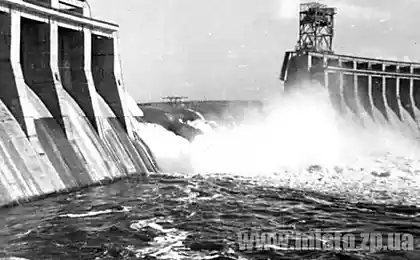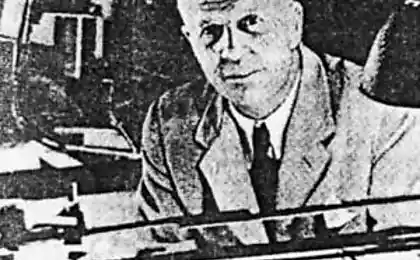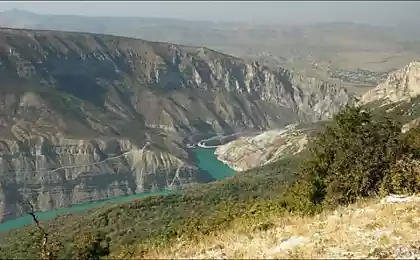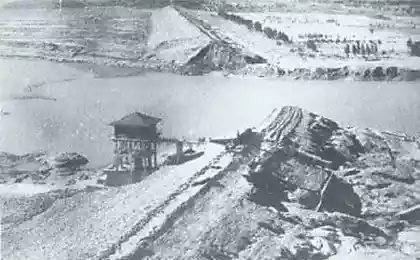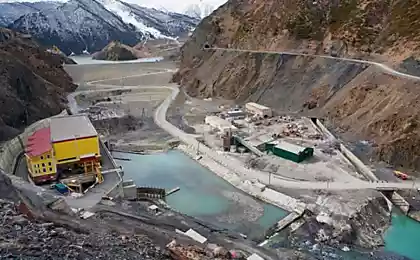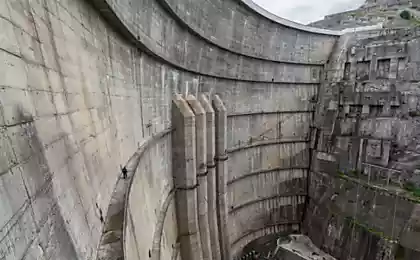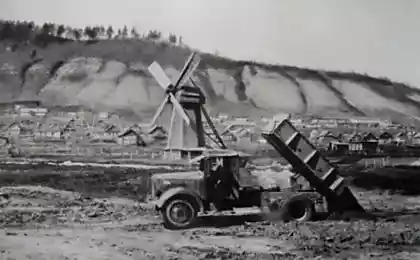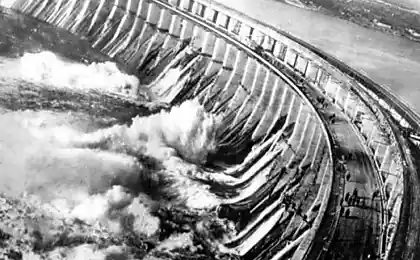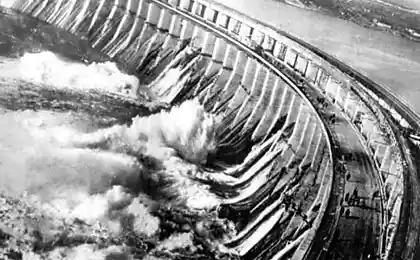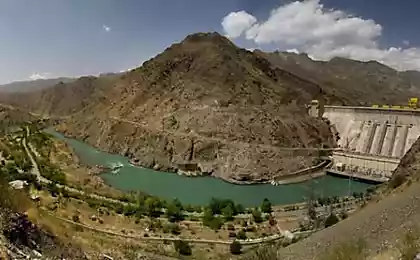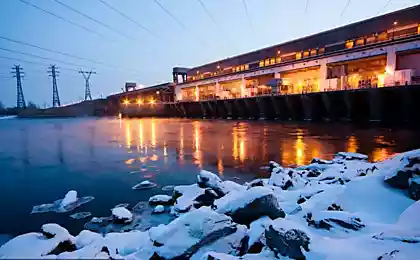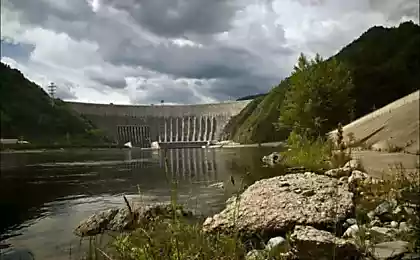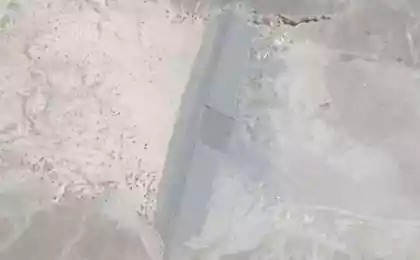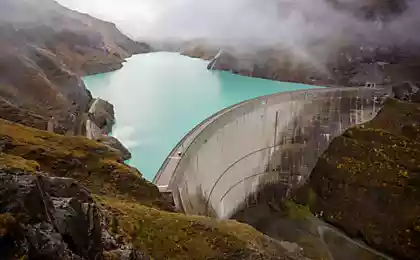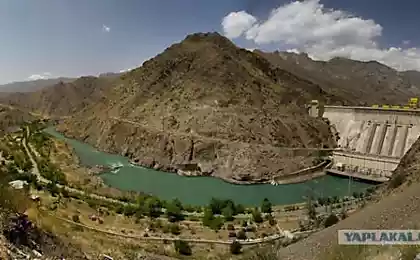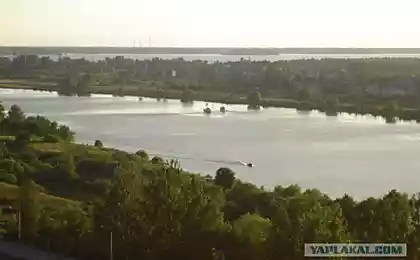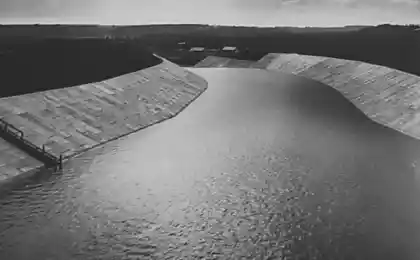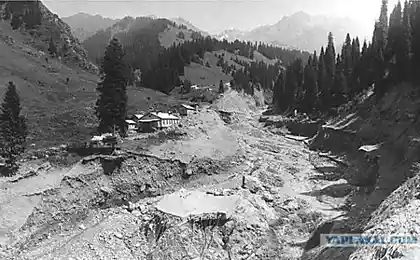2408
Why break the dam
It's about the dam of St. Francis, which was built to create a reservoir for the water supply of the city of Los Angeles. Construction took place from 1924 to 1926. Its collapse took place in March 1928, killing more than 600 people. Inside the post you will have to wait for the history of the destruction of this and as a bonus, several major dams in the world. Hoover Dam
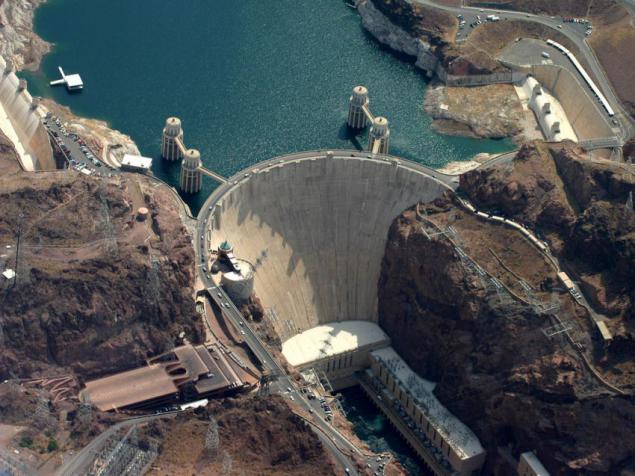
Mulholland, a self-taught engineer, he began to work with the lower levels of the Department of Energy and Water in Los Angeles, but soon established himself extremely employable, responsible engineers able to implement projects within time and budget. By the beginning of the construction of the dam of Saint Francis in his account it was for Los Angeles Aqueduct length of 380 km - at the time the longest in the world (1913). The rapid growth of Los Angeles demand to increase water supply, and along the aqueduct in 1920 was built a number of small reservoirs, however, it was clear that in general, it does not solve the problem.
In the process of exploration trails aqueduct, in 1911, Mulholland eye on portion of the canyon of the river San Frantsiskito 50 km from Los Angeles, as a potential location for the dam construction. The route of the aqueduct passed along the canyon, which made the construction of the dam the ideal solution to the problem of water supply of the city.
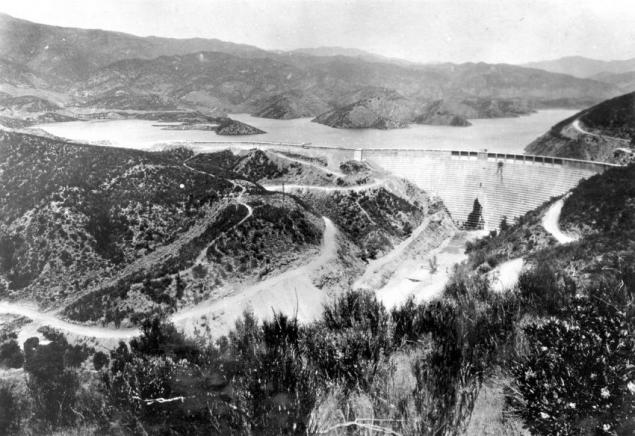
Construction
The project was conceived as a monumental structure, designed to provide water and electricity to all of Los Angeles. For this has been designed and built a giant aqueduct (372 km) across the massif of the Sierra Nevada. One only tunnels through the eastern slopes of the array was hacked 80 km. One of these tunnels began at 70 km north of Los Angeles. There, over a steep 300-meter cliff, made discontinuous down into the canyon of St. Francis, Mulholland has built two power plants which were to transform the energy of falling water in the canyon of the electricity that feeds the city. In the same place, just in the middle of the canyon, between the two power stations was planned construction of a giant dam. The excess water brought by aqueduct, were collected in a huge tank and, if necessary, the reservoir could supply water to Los Angeles for a year!
Magnificent project. But this project and called the most ridiculous and absurd project of 70-year-old builder.
In 1924, construction began on the dam - the quiet, yet it was possible - so as not to attract the attention of the farmers who took the water of the river San Frantsiskito for irrigation downstream. By the time the aqueduct itself has been repeatedly damaged by angry farmers and landowners, and Mulholland tried as much to avoid this at least in the initial stages of construction of the dam.
Immediately after the start of construction Mulholland decided to change the project and add the height of 3 meters, to increase the volume of the reservoir 36, 5 to 39 million. Cubic meters. The construction of the dam had been some minor improvements. In 1925, when the dam was about half completed, Mulholland added another 3 meters, the dam has reached 59 meters high, and the capacity of the reservoir 47 million. Cubic meters. water. New height of the dam has caused the need for the construction of training wall on the ridge of the western support of the dam to prevent seepage through the ridge.
The prelude to disaster.
Geologists have warned of the designer that he is going to build a dam on the precarious place. The weir was located along the geological fault coming to the surface. Therefore, the ground under the dam itself consisted mainly of clastic rocks, which is all the time the waters of the canyon eroded and dissolved in its waters, turning into mud from slyudyanistogo quartz. On this dirt and erected a giant dam experienced architect, is not nobody's heeding the warnings.
The height of the buildings was 62 meters, the length of the dam - 210 meters thick at the base - 52 meters. But almost immediately the concrete foundation began to flow, flowing water from the reservoir to 38,000 acre-feet of water. On the concrete wall of the dam is also designated a crack.
In 1926 and 1927 in the dam, as the filling of the tank, there were cracks. Mulholland and his assistant Harvey van Norman personally examined them and found acceptable to the concrete dam the size of St. Francis. During the last months of 1927, up to March 1928 the tank was filled with more or less constant speed. March 7 reached design level, and Mulholland ordered to stop filling. In the same week it became known about the cracks and dips in the road surface area of eastern support of the dam, the morning of March 12, roadbed sank 30 cm.
On the morning of March 12 a dam caretaker, Tony Harnishfeger, I discovered a new leak and immediately notified Mulholland, who grasped assistant, immediately went to the site for inspection. After checking - in his opinion - to a minor leak of a new, Mulholland declared the dam safe.
The destruction and flooding.
Three minutes before midnight on March 12th, 1928 St. Francis Dam collapsed. Survivors were no witnesses, motorcyclist driving along the road in a canyon near the dam, he told about the shaking and noise, that there came to him when he was 800 meters above the dam downstream. He took it as a collapse or earthquake in the usual places. Motorcyclist also noted that passing by the dam, at its foot, he watched the light - apparently the caretaker heard something and went out in the night to check.
Dam caretaker and his family were the first victims of the 38-meter wave that flowed through the canyon San Farntsiskito.
Reconstruction of events showed that the first collapsed pillar east, water rushed into the breach, the dam began to deploy, resulting in collapsed Western support - when the tank was half devastated. Left standing only the central section, or "cornerstone" as it was then called. The eastern and western sections, broken into chunks, swept 800 meters downstream.
A total of 45 billion has poured out of the tank. liters of water, first wave destroyed the concrete walls HPP downstream, then joined the Santa Clara River and flooded the city Kastayk Junction, Fillmore and Bardsdeyl. Flooding swept area of Santa Paula and Ventura, carrying the victim, tons of mud and debris into the Pacific Ocean in a 87 km from the dam. The bodies of the victims were found on the coast down to the Mexican border. The exact number of victims, no one knows - estimated number of 450 to 600. The exact count was complicated by the fact that in the canyon San Frantsiskito camped illegal immigrants from Mexico, the exact number will never be known, moreover, many bodies were buried under tons of sediment . The remains of the former flood zone found until mid-1950, the latter were discovered in 1992 ...
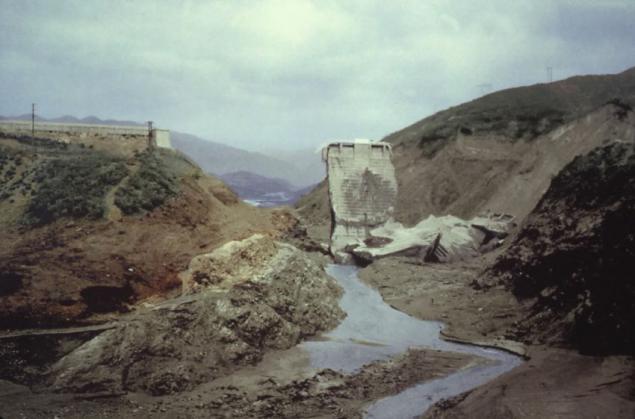
Implications.
Immediately after the disaster Mulholland said publicly that "I envy those who have died" and continued - "Do not blame anyone but myself. If it was a human error, this person I am, and I will not share the guilt or blame to someone else ».
At trial, Mulholland has confirmed its presence at the dam on the day before the disaster, and crack detection, which he then - and now - is considered insignificant.
The court decided that the cause of the disaster must be attributed largely paleorazlomu, which was discovered at the eastern pillar of the dam. The level of development of Geology early 1920, did not allow him to discover, despite the involvement of leading American geologists at the time, John C. Brunner and Karl Grunskaya from Stanford University.
According to the court, the responsibility for the catastrophe had to carry government agencies that control the design and construction, as well as the chief engineer. The court, however, did not Mulholland sentenced to any punishment, as neither he nor anyone else could not have data on the instability of the rock formations below the dam. The Court also recommended that "in the future, design, construction and supervision of large dams were not the responsibility of one person, no matter how eminent." Shortly after the trial, Mulholland has resigned and virtually isolated from society. He died in 1935 at 79 years old.
Analysis.
Subsequent studies have found that the dam was in fact in the ancient rift between the inactive shield Pelona and conglomeratic formations Sesp. Rift was moved, perhaps because of the infiltration of water from the reservoir.
As a result of the investigation all the blame and responsibility were assigned to one person, who took to themselves the right to take individual decisions concerning the construction of dams and dikes. 73-year-old William Mulholland fully accepted the blame and responsibility for the death of about 600 people.
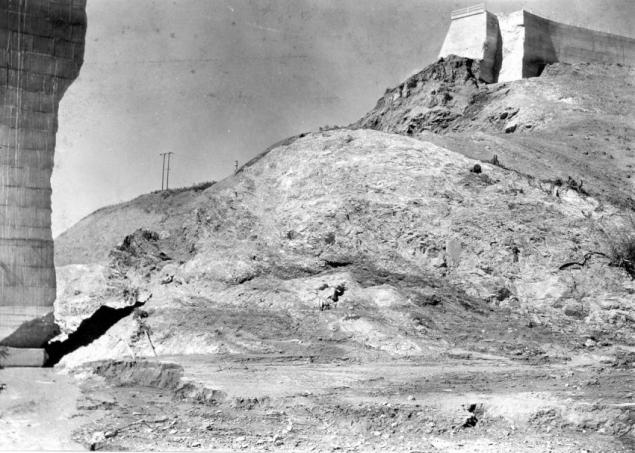
All the concrete foundation of the dam destroyed. March 17, 1928
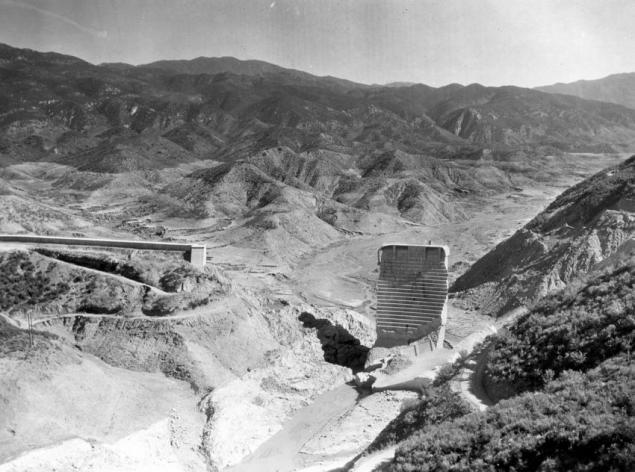
For 20 minutes before the hour X water began to leak out of the tank as a result of the leak. The flood destroyed the powerhouse located 1 km below the dam at 12.04 am March 13 1928
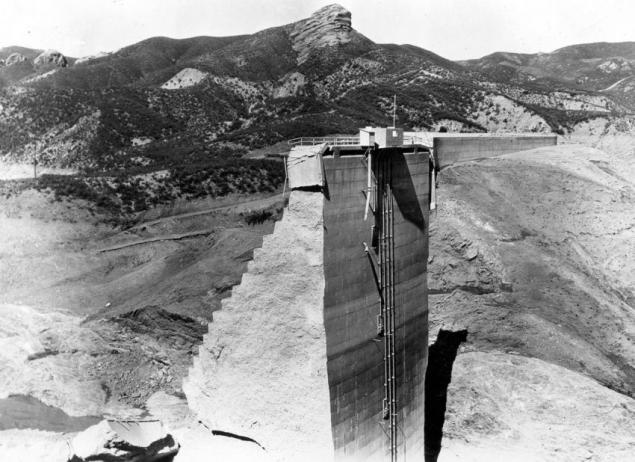
Destroyed turbine
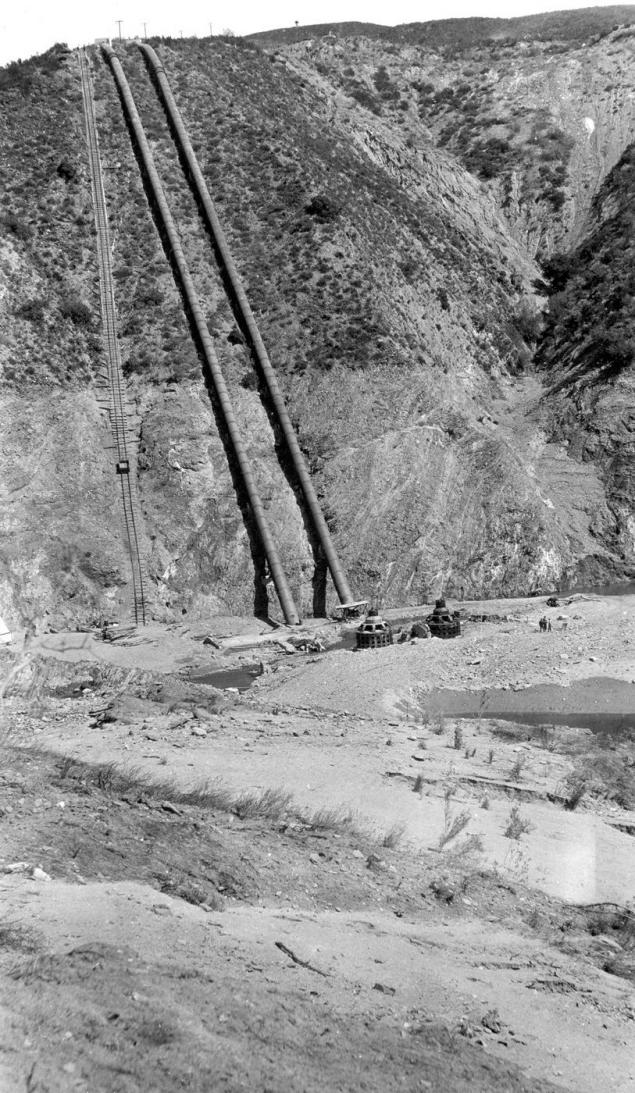
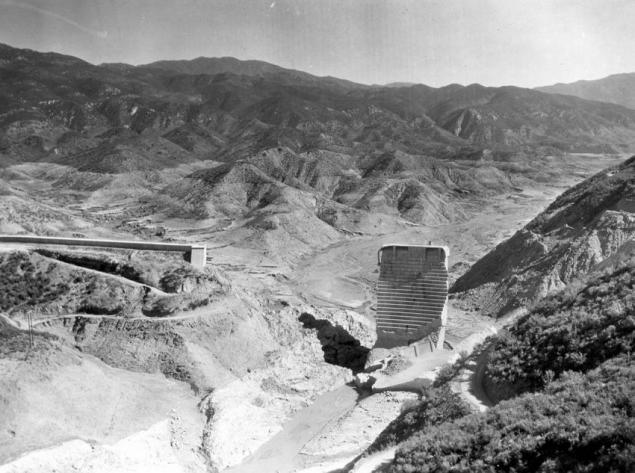
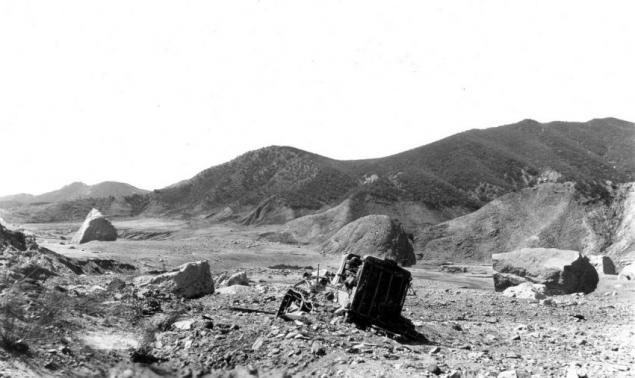
Railroad tracks between Kastikom and Piru, destroyed by the floods. Rescue Team is engaged in clearing the debris. 18 March 1928.
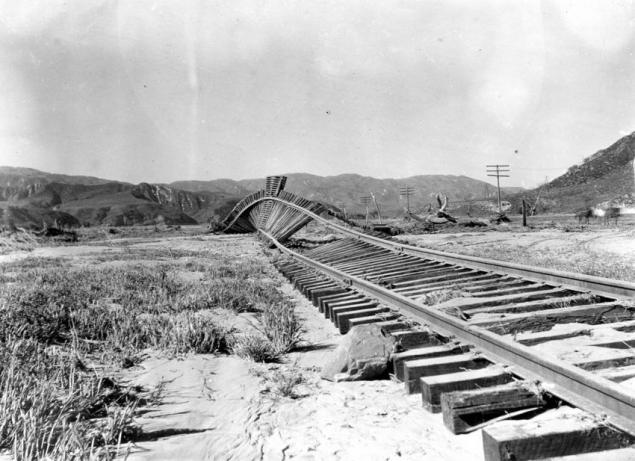
All that remained of the house, designed for fifty people at the NPP-2 in a tributary valley of the San Francisco
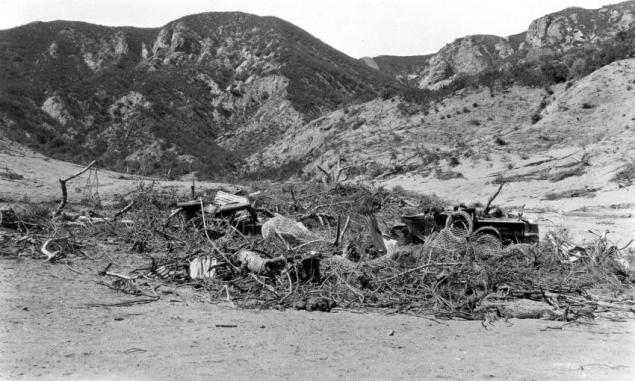
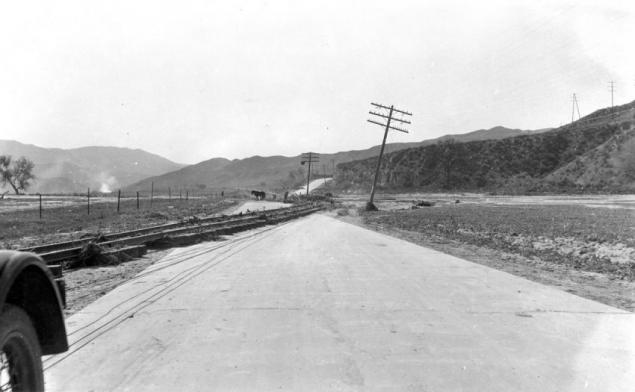
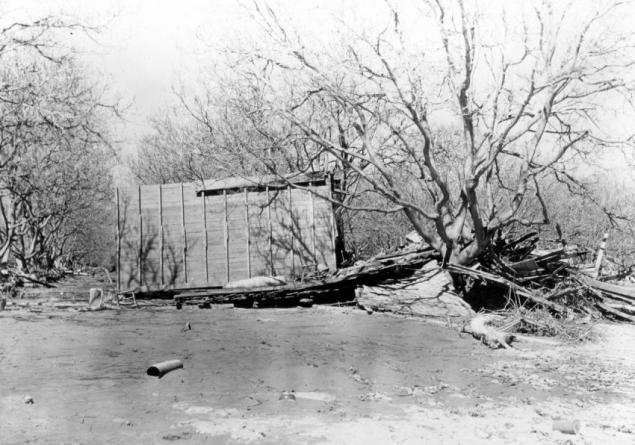
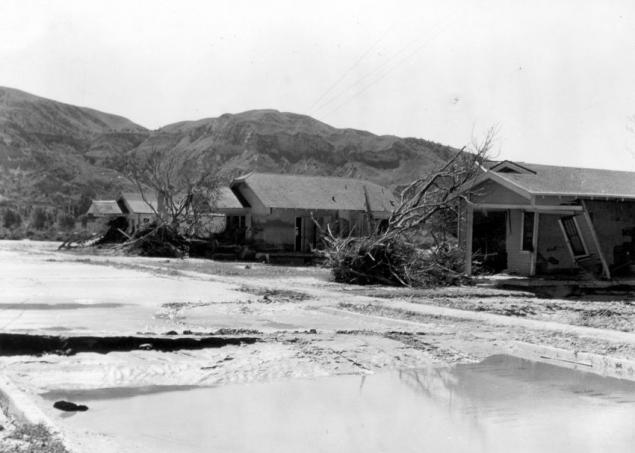
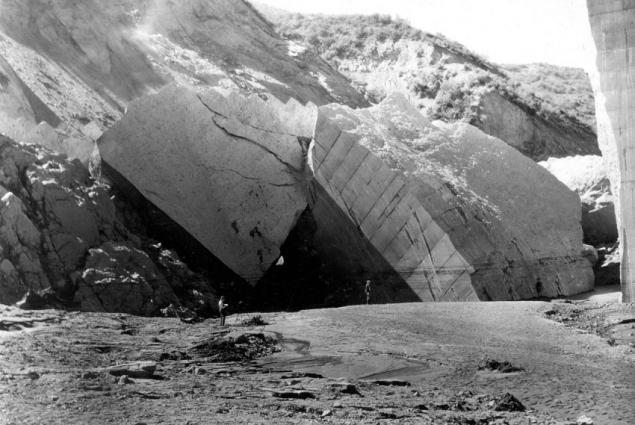
Thirty vehicles - all that remains of the camp builders near Piru. Killed eighty-nine people. 18 March 1928.
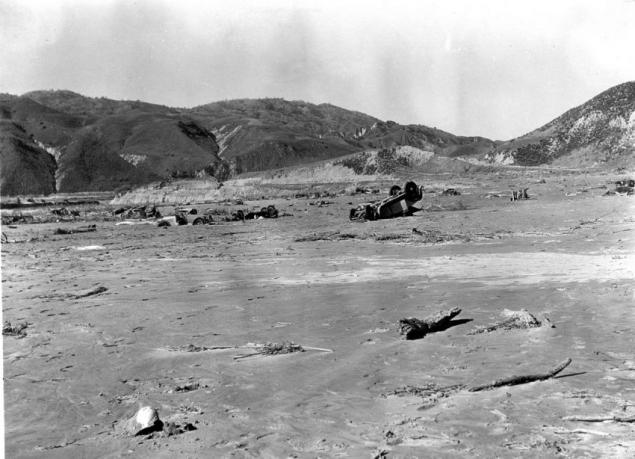
Huge concrete blocks west of the dam found about half a mile below the dam. Each block is approximately 63 feet long, 30 feet tall and 54 feet wide
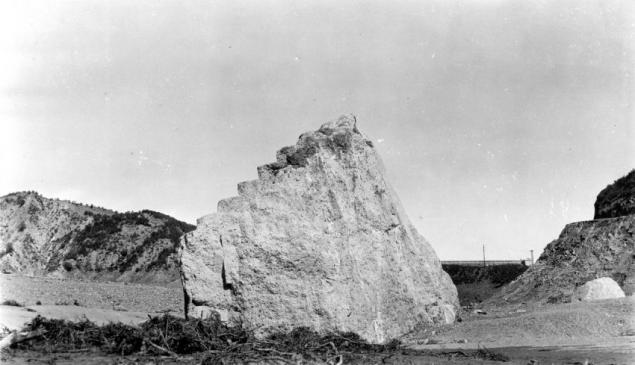
Roads between Kastikom Piru in California and blurred by the floods. 18 March 1928.
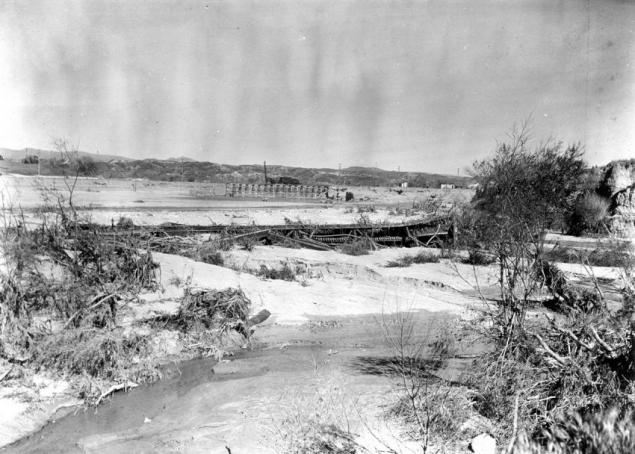
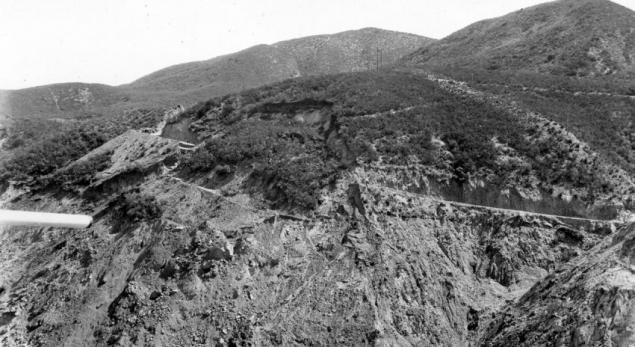
Santa Paula, after a flood destroyed the building. March 18, 1928
And disaster dams:
August 18, 1941.
Undermining Dniproges Ukraine during fierce fighting with the Nazi invaders.
A hard but necessary operation was launched by the Soviet leadership in connection with the attacks of the enemy in order to capture and Dniproges dam through which planned to break into the city of Zaporozhye. The explosion in the body of the dam formed a large hole, went active water discharge. The result is a vast area of flooding in the lower reaches of the Dnieper. A giant wave swept away several enemy crossings, sank many Nazi divisions, had taken refuge in the flooded areas. But to break free water does not divide people into "us" and "them." Almost tridtsatimetrovoy avalanche of water swept Dnipro floodplain, flooding everything in its path. The entire lower part of Zaporozhye with huge reserves of various goods, military materials and tens of thousands of tons of food and other property for some time has been taken down. Dozens of vessels with crew, perished in that terrible stream. The number of dead and material damages have been catastrophically.
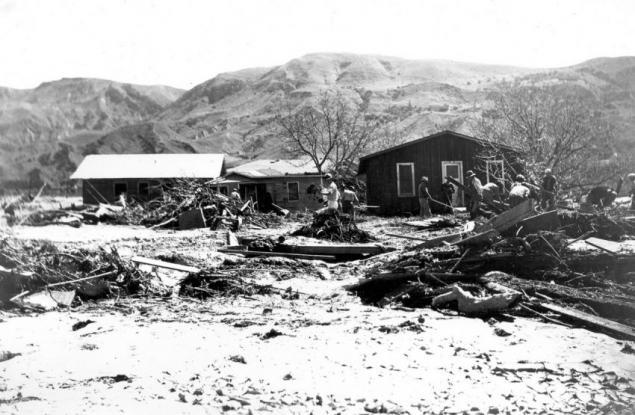
December 2nd, 1959.
On the river Reyran collapsed concrete arch Malpasset Dam crest length of 222 meters, was built about 7 kilometers north of the town of Frejus in southern France for irrigation and water supply. Reasons matured gradually, not in its entirety was carried out geological research; builders "savings" cost quality concrete due to scarce funding; in the vicinity of military facilities produces a burst; with the use of explosives near avtoshosse it was built; heavy rains overflowed the reservoir ...
Frejus has undergone almost total flooding. As a result of the floods, according to official figures, killed 423 people, the total amount of damage in monetary terms amounted to about 68 million US dollars.
October 9, 1963.
The disaster at the Vajont - one of the highest dams in the world (262 meters) in the Italian Alps.
As a result of the heavy rains came down the cliff into the reservoir. Raised a wave height of 200 meters over the crest of the dam perehlestnula.
The water washed away only about 1 meter upper layer of the dam, but it was enough to the Piave River Valley flood destroyed five villages and killed, according to various estimates, from 1900 to 2500, 350 families were killed completely. The dam resisted, but since then the reservoir is no longer filled.
August 7, 1975.
The destruction of the dam Bayntsyao in China. The height of the dam - 118 meters, tank capacity - 375 million cubic meters.
As a result of loss for one day of annual rainfall and overflow reservoir dam failure occurred, which resulted in a tidal wave height 3-7 meters and a width of 10 kilometers.
It was flooded seven regional centers and countless villages. According to official data of all the floods killed 26 thousand people and 145 thousand people were killed immediately and then because of hunger and epidemics. It was destroyed 5.96 million houses, one way or another affected 11 million people.
June 1993.
Breakthrough of the dam length of 2 kilometers and a height of 17 meters at the dam on the river Kiselevsk Kakva River 17 kilometers from the town of Serov, Sverdlovsk region of the Russian Federation.
When filling the reservoir of the dam break occurred.
Affected by the floods 6, 5 thousand people, 12 people were killed. In 1772 a flood zone got home from their 1250 became unsuitable for housing. It was destroyed railway and road bridges 5, blurry 500 meters of the main railway line.
August 2009.
The accident in the Russian Federation at the Sayano-Shushenskaya hydroelectric power plant between the Krasnoyarsk Territory and Khakassia - industrial technological disaster.
The accident killed 75 people, equipment and premises of the station suffered serious damage. Work stations for electricity production was suspended. Consequences of the accident impact on environmental conditions the waters adjacent to the hydroelectric power station, on the social and economic spheres of the region. The amount of damage was more than 40 billion rubles.
June 2010.
A dam burst Fuhe River in Jiangxi province in eastern China due to heavy rains.
From the zone of the breakthrough it was evacuated about 100 thousand people. Just ten territorial units of southern and eastern China due to heavy rains that caused flooding and landslides killed 199 people missing, 123 people. From dangerous areas had been evacuated almost 2, 4 million people. One way or another from the disaster affected 29 million people. Economic damage from the weather was about 42 billion yuan (6 US $ 2 billion).
August 5, 2010.
Breakthrough of the dam on the Indus River in southern Pakistane.Unichtozheno to 895 thousand houses, flooded more than 2 million hectares of agricultural land. More than 1,700 people were killed. Flood, according to the UN, has affected up to 20 million people in the country.
September 1, 2011.
Breakthrough of the dam on the Qiantang River near the city of Hangzhou in Zhejiang province in east China.
Usually tourists tend to admire the unique natural phenomenon - the highest in the world, up to 9 meters in a tidal wave. But sometimes wave perehlёstyvaet through dams, from which in 1993 killed 59 people in 2007 - 11 people. At this time a wave broke the dam and washed away many.
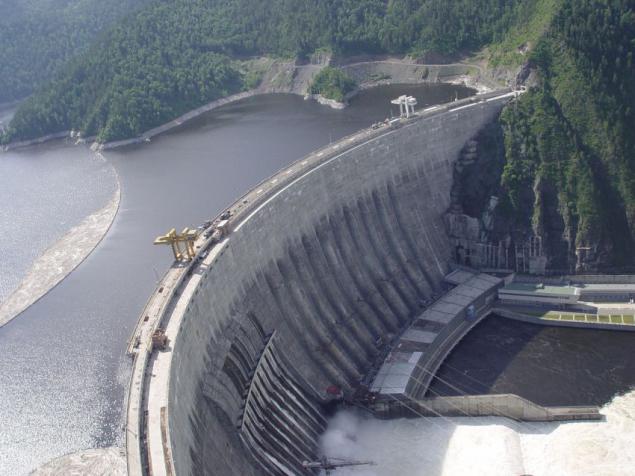
Source: masterok.livejournal.com

Mulholland, a self-taught engineer, he began to work with the lower levels of the Department of Energy and Water in Los Angeles, but soon established himself extremely employable, responsible engineers able to implement projects within time and budget. By the beginning of the construction of the dam of Saint Francis in his account it was for Los Angeles Aqueduct length of 380 km - at the time the longest in the world (1913). The rapid growth of Los Angeles demand to increase water supply, and along the aqueduct in 1920 was built a number of small reservoirs, however, it was clear that in general, it does not solve the problem.
In the process of exploration trails aqueduct, in 1911, Mulholland eye on portion of the canyon of the river San Frantsiskito 50 km from Los Angeles, as a potential location for the dam construction. The route of the aqueduct passed along the canyon, which made the construction of the dam the ideal solution to the problem of water supply of the city.

Construction
The project was conceived as a monumental structure, designed to provide water and electricity to all of Los Angeles. For this has been designed and built a giant aqueduct (372 km) across the massif of the Sierra Nevada. One only tunnels through the eastern slopes of the array was hacked 80 km. One of these tunnels began at 70 km north of Los Angeles. There, over a steep 300-meter cliff, made discontinuous down into the canyon of St. Francis, Mulholland has built two power plants which were to transform the energy of falling water in the canyon of the electricity that feeds the city. In the same place, just in the middle of the canyon, between the two power stations was planned construction of a giant dam. The excess water brought by aqueduct, were collected in a huge tank and, if necessary, the reservoir could supply water to Los Angeles for a year!
Magnificent project. But this project and called the most ridiculous and absurd project of 70-year-old builder.
In 1924, construction began on the dam - the quiet, yet it was possible - so as not to attract the attention of the farmers who took the water of the river San Frantsiskito for irrigation downstream. By the time the aqueduct itself has been repeatedly damaged by angry farmers and landowners, and Mulholland tried as much to avoid this at least in the initial stages of construction of the dam.
Immediately after the start of construction Mulholland decided to change the project and add the height of 3 meters, to increase the volume of the reservoir 36, 5 to 39 million. Cubic meters. The construction of the dam had been some minor improvements. In 1925, when the dam was about half completed, Mulholland added another 3 meters, the dam has reached 59 meters high, and the capacity of the reservoir 47 million. Cubic meters. water. New height of the dam has caused the need for the construction of training wall on the ridge of the western support of the dam to prevent seepage through the ridge.
The prelude to disaster.
Geologists have warned of the designer that he is going to build a dam on the precarious place. The weir was located along the geological fault coming to the surface. Therefore, the ground under the dam itself consisted mainly of clastic rocks, which is all the time the waters of the canyon eroded and dissolved in its waters, turning into mud from slyudyanistogo quartz. On this dirt and erected a giant dam experienced architect, is not nobody's heeding the warnings.
The height of the buildings was 62 meters, the length of the dam - 210 meters thick at the base - 52 meters. But almost immediately the concrete foundation began to flow, flowing water from the reservoir to 38,000 acre-feet of water. On the concrete wall of the dam is also designated a crack.
In 1926 and 1927 in the dam, as the filling of the tank, there were cracks. Mulholland and his assistant Harvey van Norman personally examined them and found acceptable to the concrete dam the size of St. Francis. During the last months of 1927, up to March 1928 the tank was filled with more or less constant speed. March 7 reached design level, and Mulholland ordered to stop filling. In the same week it became known about the cracks and dips in the road surface area of eastern support of the dam, the morning of March 12, roadbed sank 30 cm.
On the morning of March 12 a dam caretaker, Tony Harnishfeger, I discovered a new leak and immediately notified Mulholland, who grasped assistant, immediately went to the site for inspection. After checking - in his opinion - to a minor leak of a new, Mulholland declared the dam safe.
The destruction and flooding.
Three minutes before midnight on March 12th, 1928 St. Francis Dam collapsed. Survivors were no witnesses, motorcyclist driving along the road in a canyon near the dam, he told about the shaking and noise, that there came to him when he was 800 meters above the dam downstream. He took it as a collapse or earthquake in the usual places. Motorcyclist also noted that passing by the dam, at its foot, he watched the light - apparently the caretaker heard something and went out in the night to check.
Dam caretaker and his family were the first victims of the 38-meter wave that flowed through the canyon San Farntsiskito.
Reconstruction of events showed that the first collapsed pillar east, water rushed into the breach, the dam began to deploy, resulting in collapsed Western support - when the tank was half devastated. Left standing only the central section, or "cornerstone" as it was then called. The eastern and western sections, broken into chunks, swept 800 meters downstream.
A total of 45 billion has poured out of the tank. liters of water, first wave destroyed the concrete walls HPP downstream, then joined the Santa Clara River and flooded the city Kastayk Junction, Fillmore and Bardsdeyl. Flooding swept area of Santa Paula and Ventura, carrying the victim, tons of mud and debris into the Pacific Ocean in a 87 km from the dam. The bodies of the victims were found on the coast down to the Mexican border. The exact number of victims, no one knows - estimated number of 450 to 600. The exact count was complicated by the fact that in the canyon San Frantsiskito camped illegal immigrants from Mexico, the exact number will never be known, moreover, many bodies were buried under tons of sediment . The remains of the former flood zone found until mid-1950, the latter were discovered in 1992 ...

Implications.
Immediately after the disaster Mulholland said publicly that "I envy those who have died" and continued - "Do not blame anyone but myself. If it was a human error, this person I am, and I will not share the guilt or blame to someone else ».
At trial, Mulholland has confirmed its presence at the dam on the day before the disaster, and crack detection, which he then - and now - is considered insignificant.
The court decided that the cause of the disaster must be attributed largely paleorazlomu, which was discovered at the eastern pillar of the dam. The level of development of Geology early 1920, did not allow him to discover, despite the involvement of leading American geologists at the time, John C. Brunner and Karl Grunskaya from Stanford University.
According to the court, the responsibility for the catastrophe had to carry government agencies that control the design and construction, as well as the chief engineer. The court, however, did not Mulholland sentenced to any punishment, as neither he nor anyone else could not have data on the instability of the rock formations below the dam. The Court also recommended that "in the future, design, construction and supervision of large dams were not the responsibility of one person, no matter how eminent." Shortly after the trial, Mulholland has resigned and virtually isolated from society. He died in 1935 at 79 years old.
Analysis.
Subsequent studies have found that the dam was in fact in the ancient rift between the inactive shield Pelona and conglomeratic formations Sesp. Rift was moved, perhaps because of the infiltration of water from the reservoir.
As a result of the investigation all the blame and responsibility were assigned to one person, who took to themselves the right to take individual decisions concerning the construction of dams and dikes. 73-year-old William Mulholland fully accepted the blame and responsibility for the death of about 600 people.

All the concrete foundation of the dam destroyed. March 17, 1928

For 20 minutes before the hour X water began to leak out of the tank as a result of the leak. The flood destroyed the powerhouse located 1 km below the dam at 12.04 am March 13 1928

Destroyed turbine



Railroad tracks between Kastikom and Piru, destroyed by the floods. Rescue Team is engaged in clearing the debris. 18 March 1928.

All that remained of the house, designed for fifty people at the NPP-2 in a tributary valley of the San Francisco





Thirty vehicles - all that remains of the camp builders near Piru. Killed eighty-nine people. 18 March 1928.

Huge concrete blocks west of the dam found about half a mile below the dam. Each block is approximately 63 feet long, 30 feet tall and 54 feet wide

Roads between Kastikom Piru in California and blurred by the floods. 18 March 1928.


Santa Paula, after a flood destroyed the building. March 18, 1928
And disaster dams:
August 18, 1941.
Undermining Dniproges Ukraine during fierce fighting with the Nazi invaders.
A hard but necessary operation was launched by the Soviet leadership in connection with the attacks of the enemy in order to capture and Dniproges dam through which planned to break into the city of Zaporozhye. The explosion in the body of the dam formed a large hole, went active water discharge. The result is a vast area of flooding in the lower reaches of the Dnieper. A giant wave swept away several enemy crossings, sank many Nazi divisions, had taken refuge in the flooded areas. But to break free water does not divide people into "us" and "them." Almost tridtsatimetrovoy avalanche of water swept Dnipro floodplain, flooding everything in its path. The entire lower part of Zaporozhye with huge reserves of various goods, military materials and tens of thousands of tons of food and other property for some time has been taken down. Dozens of vessels with crew, perished in that terrible stream. The number of dead and material damages have been catastrophically.

December 2nd, 1959.
On the river Reyran collapsed concrete arch Malpasset Dam crest length of 222 meters, was built about 7 kilometers north of the town of Frejus in southern France for irrigation and water supply. Reasons matured gradually, not in its entirety was carried out geological research; builders "savings" cost quality concrete due to scarce funding; in the vicinity of military facilities produces a burst; with the use of explosives near avtoshosse it was built; heavy rains overflowed the reservoir ...
Frejus has undergone almost total flooding. As a result of the floods, according to official figures, killed 423 people, the total amount of damage in monetary terms amounted to about 68 million US dollars.
October 9, 1963.
The disaster at the Vajont - one of the highest dams in the world (262 meters) in the Italian Alps.
As a result of the heavy rains came down the cliff into the reservoir. Raised a wave height of 200 meters over the crest of the dam perehlestnula.
The water washed away only about 1 meter upper layer of the dam, but it was enough to the Piave River Valley flood destroyed five villages and killed, according to various estimates, from 1900 to 2500, 350 families were killed completely. The dam resisted, but since then the reservoir is no longer filled.
August 7, 1975.
The destruction of the dam Bayntsyao in China. The height of the dam - 118 meters, tank capacity - 375 million cubic meters.
As a result of loss for one day of annual rainfall and overflow reservoir dam failure occurred, which resulted in a tidal wave height 3-7 meters and a width of 10 kilometers.
It was flooded seven regional centers and countless villages. According to official data of all the floods killed 26 thousand people and 145 thousand people were killed immediately and then because of hunger and epidemics. It was destroyed 5.96 million houses, one way or another affected 11 million people.
June 1993.
Breakthrough of the dam length of 2 kilometers and a height of 17 meters at the dam on the river Kiselevsk Kakva River 17 kilometers from the town of Serov, Sverdlovsk region of the Russian Federation.
When filling the reservoir of the dam break occurred.
Affected by the floods 6, 5 thousand people, 12 people were killed. In 1772 a flood zone got home from their 1250 became unsuitable for housing. It was destroyed railway and road bridges 5, blurry 500 meters of the main railway line.
August 2009.
The accident in the Russian Federation at the Sayano-Shushenskaya hydroelectric power plant between the Krasnoyarsk Territory and Khakassia - industrial technological disaster.
The accident killed 75 people, equipment and premises of the station suffered serious damage. Work stations for electricity production was suspended. Consequences of the accident impact on environmental conditions the waters adjacent to the hydroelectric power station, on the social and economic spheres of the region. The amount of damage was more than 40 billion rubles.
June 2010.
A dam burst Fuhe River in Jiangxi province in eastern China due to heavy rains.
From the zone of the breakthrough it was evacuated about 100 thousand people. Just ten territorial units of southern and eastern China due to heavy rains that caused flooding and landslides killed 199 people missing, 123 people. From dangerous areas had been evacuated almost 2, 4 million people. One way or another from the disaster affected 29 million people. Economic damage from the weather was about 42 billion yuan (6 US $ 2 billion).
August 5, 2010.
Breakthrough of the dam on the Indus River in southern Pakistane.Unichtozheno to 895 thousand houses, flooded more than 2 million hectares of agricultural land. More than 1,700 people were killed. Flood, according to the UN, has affected up to 20 million people in the country.
September 1, 2011.
Breakthrough of the dam on the Qiantang River near the city of Hangzhou in Zhejiang province in east China.
Usually tourists tend to admire the unique natural phenomenon - the highest in the world, up to 9 meters in a tidal wave. But sometimes wave perehlёstyvaet through dams, from which in 1993 killed 59 people in 2007 - 11 people. At this time a wave broke the dam and washed away many.

Source: masterok.livejournal.com
